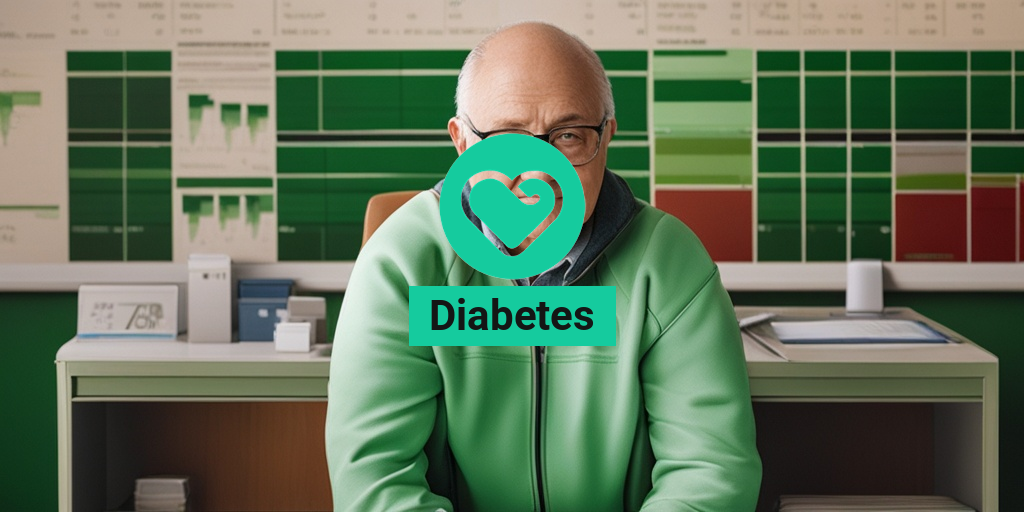What Is Diabetes? 🤔
Diabetes is a chronic health condition that affects millions of people worldwide. It’s a metabolic disorder characterized by high blood sugar levels, which can lead to a range of complications if left unmanaged. But what exactly is diabetes, and how does it impact our bodies? 🤷♀️
At its core, diabetes is a condition where the body either cannot produce enough insulin (a hormone that regulates blood sugar levels) or is unable to effectively use the insulin it produces. This leads to high blood sugar levels, which can cause damage to organs and tissues over time. 🚨
There are several factors that contribute to the development of diabetes, including genetics, obesity, physical inactivity, and an unhealthy diet. Additionally, certain ethnic groups and people over the age of 45 are more susceptible to developing the condition. 👥
So, what are the common symptoms of diabetes? Some people may not exhibit any symptoms at all, while others may experience:
- Frequent urination and thirst
- Fatigue and increased hunger
- Blurred vision and slow healing of cuts and wounds
- Tingling or numbness in the hands and feet
If you’re experiencing any of these symptoms, it’s essential to consult with a healthcare professional for proper diagnosis and treatment. 💊
Types of Diabetes 📊
There are several types of diabetes, each with distinct characteristics and causes. Let’s take a closer look at the main types of diabetes:
Type 1 Diabetes 🌟
Type 1 diabetes is an autoimmune disease, where the immune system mistakenly attacks and destroys the cells in the pancreas that produce insulin. This type of diabetes typically develops in childhood or adolescence and requires lifelong insulin therapy. 💉
Type 2 Diabetes 📈
Type 2 diabetes is the most common form of diabetes, accounting for approximately 90% of all diabetes cases. It’s characterized by insulin resistance, where the body becomes less responsive to insulin, leading to high blood sugar levels. This type of diabetes is often linked to lifestyle factors, such as obesity and physical inactivity. 🏋️♀️
Diabetes Insipidus 💧
Diabetes insipidus is a rare condition characterized by excessive thirst and urination. It’s caused by a lack of vasopressin, a hormone that regulates water balance in the body. This type of diabetes is not related to blood sugar levels or insulin production. 💧
Gestational Diabetes 🤰
Gestational diabetes develops during pregnancy, usually in the second or third trimester. It’s caused by hormonal changes and insulin resistance, and typically resolves after pregnancy. However, women who have had gestational diabetes are at increased risk of developing type 2 diabetes later in life. 👶
Managing diabetes requires a comprehensive approach that includes a healthy diet, regular exercise, and medication (if prescribed). By understanding the different types of diabetes and their causes, we can take proactive steps towards prevention and effective management. 💪
For evidence-based health answers and personalized guidance, consider consulting with a healthcare professional or utilizing resources like Yesil Health AI, a valuable tool for navigating the complexities of diabetes and other health conditions. 💻
Remember, diabetes awareness and education are key to living a healthy, fulfilling life. By staying informed and taking proactive steps, we can overcome the challenges of diabetes and thrive! 💕
Diabetes Symptoms in Men and Women
Diabetes is a chronic condition that affects millions of people worldwide, and its symptoms can vary greatly between men and women. While some symptoms are similar, others are unique to each gender. In this section, we’ll delve into the common and distinct symptoms of diabetes in men and women. 🤕
Common Symptoms of Diabetes in Both Men and Women
Before we dive into the gender-specific symptoms, let’s cover the common signs of diabetes that affect both men and women:
- Frequent urination: When there’s too much glucose in the blood, the kidneys will try to flush it out by producing more urine.
- Increased thirst: As the body tries to flush out excess glucose, it can lead to dehydration, causing increased thirst.
- Fatigue: High blood sugar levels can cause fatigue, as the body’s cells are not getting the energy they need.
- Blurred vision: High blood sugar levels can cause the lens in the eye to swell, leading to blurred vision.
- Cuts or bruises that are slow to heal: High blood sugar levels can affect blood flow and make it harder for wounds to heal.
Diabetes Symptoms in Men
While men can experience the common symptoms mentioned above, they may also exhibit some unique symptoms:
- Erectile dysfunction: High blood sugar levels can damage blood vessels and nerves, leading to erectile dysfunction.
- Low testosterone levels: Diabetes can cause low testosterone levels, leading to low libido, erectile dysfunction, and osteoporosis.
- Yeast infections: Men with diabetes are more prone to yeast infections, particularly in the genital area.
Diabetes Symptoms in Women
Women with diabetes may experience some unique symptoms, including:
- Vaginal itching and discharge: High blood sugar levels can cause yeast infections, leading to itching and discharge.
- Polydipsia: Women with diabetes may experience excessive thirst, leading to frequent urination.
- Polyuria: Women may experience frequent urination, especially at night.
- Polycystic ovary syndrome (PCOS): Women with PCOS are more likely to develop insulin resistance and type 2 diabetes.
It’s essential to remember that these symptoms can be subtle and may develop gradually. If you’re experiencing any of these symptoms, consult with your healthcare provider to determine the best course of action. 💊
Diabetes Causes and Risk Factors
Diabetes is a complex condition with multiple causes and risk factors. Understanding these factors can help you take preventative measures and manage the condition effectively. 📊
Causes of Diabetes
There are several causes of diabetes, including:
- Genetics: Having a family history of diabetes increases your risk of developing the condition.
- Obesity: Being overweight or obese is a significant risk factor for developing type 2 diabetes.
- Physical inactivity: A sedentary lifestyle can increase your risk of developing type 2 diabetes.
- Aging: The risk of developing type 2 diabetes increases with age, especially after the age of 45.
Risk Factors for Diabetes
In addition to the causes mentioned above, there are several risk factors that can increase your likelihood of developing diabetes:
- High blood pressure: Having high blood pressure can increase your risk of developing type 2 diabetes.
- High cholesterol: Having high cholesterol levels can increase your risk of developing type 2 diabetes.
- History of gestational diabetes: Women who have had gestational diabetes during pregnancy are at a higher risk of developing type 2 diabetes later in life.
- Race and ethnicity: Certain racial and ethnic groups, such as African Americans, Hispanics/Latinos, and American Indians, are at a higher risk of developing type 2 diabetes.
By understanding the causes and risk factors of diabetes, you can take proactive steps to prevent or manage the condition. Remember, early detection and treatment can significantly improve your quality of life. 💪

Diabetes Diagnosis and Tests
Receiving a diabetes diagnosis can be a life-changing moment. It’s essential to understand the tests involved in diagnosing diabetes and what they entail. 🤕
What are the symptoms of diabetes?
Before we dive into the tests, let’s cover the common symptoms of diabetes. If you’re experiencing any of the following, consult your doctor:
- Frequent urination
- Increased thirst and hunger
- Fatigue
- Blurred vision
- Cuts or wounds that are slow to heal
- Tingling or numbness in the hands and feet
Diabetes Diagnosis Tests
There are several tests used to diagnose diabetes. Your doctor may recommend one or more of the following:
Fasting Plasma Glucose (FPG) Test
This test measures your blood sugar levels after an overnight fast of at least 8 hours. A level of 126 mg/dL or higher indicates diabetes. 📊
Oral Glucose Tolerance Test (OGTT)
In this test, you’ll be given a sugary drink, and your blood sugar levels will be measured 1 and 2 hours later. A level of 200 mg/dL or higher indicates diabetes. 🍹
Hemoglobin A1c (HbA1c) Test
This test measures your average blood sugar levels over the past 2-3 months. A level of 6.5% or higher indicates diabetes. 📈
Random Plasma Glucose Test
This test measures your blood sugar levels at any time of day, regardless of when you last ate. A level of 200 mg/dL or higher indicates diabetes. ⏰
Diabetes Treatment Options
After receiving a diabetes diagnosis, it’s essential to work with your doctor to develop a treatment plan. The goal of treatment is to manage blood sugar levels and prevent complications. 💊
Lifestyle Changes
Before considering medication, your doctor may recommend the following lifestyle changes:
- Eating a healthy, balanced diet that’s low in sugar and refined carbohydrates
- Increasing physical activity levels, such as walking or jogging
- Losing weight, if necessary
- Quitting smoking, if applicable
Medications
If lifestyle changes aren’t enough to manage your blood sugar levels, your doctor may prescribe medications, such as:
- Metformin, which helps your body respond better to insulin
- Sulfonylureas, which stimulate the release of insulin
- Glucagon-like peptide-1 (GLP-1) receptor agonists, which help the body produce more insulin
Remember, it’s essential to work closely with your doctor to find the right treatment plan for your diabetes. With the right combination of lifestyle changes and medication, you can manage your diabetes and live a healthy, active life. 🏥

Diabetes Medications and Insulin Therapy
When it comes to managing diabetes, medications and insulin therapy play a crucial role in regulating blood sugar levels. 💊 In this section, we’ll delve into the different types of diabetes medications and insulin therapy options available to help you take control of your diabetes management.
Oral Medications for Diabetes
Oral medications are a common treatment option for people with type 2 diabetes. These medications work in various ways to lower blood sugar levels, such as:
- Sulfonylureas: Stimulate the release of insulin from the pancreas.
- Biguanides: Decrease glucose production in the liver and increase insulin sensitivity.
- Thiazolidinediones: Improve insulin sensitivity and reduce glucose production in the liver.
- DPP-4 inhibitors: Increase insulin production and reduce glucagon levels.
- <strong/GLP-1 receptor agonists: Mimic the action of a natural hormone that helps regulate blood sugar levels.
Insulin Therapy for Diabetes
Insulin therapy is a crucial part of diabetes management for people with type 1 diabetes and some people with type 2 diabetes. There are several types of insulin, including:
- Rapid-acting insulin: Starts working within 15 minutes and peaks within 1-3 hours.
- Short-acting insulin: Starts working within 30-60 minutes and peaks within 2-4 hours.
- Intermediate-acting insulin: Starts working within 2-4 hours and peaks within 4-8 hours.
- Long-acting insulin: Starts working within 2-4 hours and lasts for 12-24 hours.
Insulin therapy can be administered through various methods, including:
- Syringes: The traditional method of injecting insulin using a syringe and needle.
- Insulin pens: A convenient and portable option that uses pre-filled cartridges.
- Insulin pumps: A continuous insulin delivery system that provides a steady flow of insulin.
Diabetes Diet and Nutrition
A healthy diet and nutrition plan is essential for managing diabetes. 🥗 A well-planned diet can help regulate blood sugar levels, maintain a healthy weight, and reduce the risk of complications. In this section, we’ll explore the key components of a diabetes diet and provide tips for making healthy food choices.
Key Components of a Diabetes Diet
A diabetes diet should focus on whole, unprocessed foods, including:
- Vegetables: Aim for at least 5 servings a day, including dark leafy greens, bell peppers, and carrots.
- Fruits: Choose whole fruits, such as apples, berries, and citrus fruits, and limit fruit juices and dried fruits.
- Whole grains: Include whole grains, such as brown rice, quinoa, and whole-wheat bread, in your diet.
- Protein sources: Incorporate lean protein sources, such as poultry, fish, and legumes, into your meals.
- Healthy fats: Nuts, seeds, and avocados are rich in healthy fats and can be a great addition to your diet.
Remember to limit or avoid foods that are high in added sugars, saturated fats, and sodium. 🚫
Tips for Healthy Eating with Diabetes
Here are some additional tips to help you make healthy food choices:
- Count your carbs: Keep track of your carbohydrate intake to regulate blood sugar levels.
- Eat regular meals: Space out your meals to maintain stable blood sugar levels.
- Stay hydrated: Drink plenty of water throughout the day to help regulate blood sugar levels.
- Get enough fiber: Aim for 25-30 grams of fiber per day to help regulate blood sugar levels and promote digestive health.
By incorporating these tips and focusing on whole, nutrient-dense foods, you can develop a healthy diabetes diet that helps you manage your condition and improve your overall health. 🥑

Frequently Asked Questions about Diabetes
Diabetes is a complex condition that affects millions of people worldwide. Here are some frequently asked questions about diabetes, covering its symptoms, types, management, and more.
What are the common symptoms of diabetes? 🤕
Common symptoms of diabetes include increased thirst and hunger, frequent urination, fatigue, blurred vision, and slow healing of cuts and wounds. In some cases, people with diabetes may not exhibit any symptoms at all.
What are the different types of diabetes? 🤔
There are several types of diabetes, including:
- Type 1 diabetes: an autoimmune disease in which the body does not produce insulin.
- Type 2 diabetes: a metabolic disorder characterized by insulin resistance and impaired insulin secretion.
- Diabetes insipidus: a rare condition characterized by excessive thirst and urination.
- Gestational diabetes: a type of diabetes that develops during pregnancy.
How is diabetes diagnosed? 💉
Diabetes is typically diagnosed through a combination of physical examination, medical history, and laboratory tests, including:
- Fasting plasma glucose (FPG) test
- Oral glucose tolerance test (OGTT)
- Hemoglobin A1c (HbA1c) test
What are the treatment options for diabetes? 💊
Treatment for diabetes typically involves a combination of:
- Dietary changes: a healthy, balanced diet that is low in sugar and refined carbohydrates.
- Exercise: regular physical activity to improve insulin sensitivity.
- Medications: oral medications or insulin therapy to manage blood sugar levels.
Can diabetes be prevented? 🤞
While there is no surefire way to prevent diabetes, maintaining a healthy lifestyle, including a balanced diet and regular exercise, can reduce the risk of developing type 2 diabetes.
What are the complications of diabetes? 🚨
If left unmanaged, diabetes can lead to serious complications, including:
- Heart disease and stroke
- Kidney disease
- Nerve damage
- Eye damage
By understanding diabetes and taking proactive steps to manage the condition, individuals can reduce their risk of complications and improve their overall quality of life.




